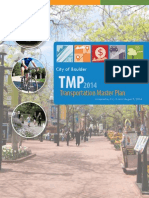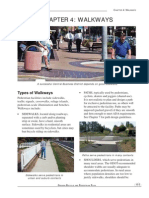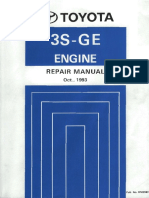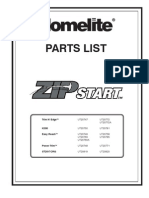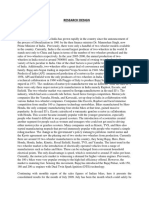Bike Lane Design Guidelines 09-22-2014
Bike Lane Design Guidelines 09-22-2014
Uploaded by
civilanCopyright:
Available Formats
Bike Lane Design Guidelines 09-22-2014
Bike Lane Design Guidelines 09-22-2014
Uploaded by
civilanOriginal Description:
Copyright
Available Formats
Share this document
Did you find this document useful?
Is this content inappropriate?
Copyright:
Available Formats
Bike Lane Design Guidelines 09-22-2014
Bike Lane Design Guidelines 09-22-2014
Uploaded by
civilanCopyright:
Available Formats
BIKE LANE
DESIGN GUIDELINES
Published September 22, 2014
Bike Lane Design Guide 2014
Introduction
The following guidelines take
material from various published
documents such as the Guide for
the Development of Bicycle
Facilities -2012 Fourth Edition
and the Urban Bikeway Design
Guide, published by the National
Association of City Transportation
Officials.
CITY OF COLUMBUS
Bike Lanes
There are many details that are
part of the design of high quality
bike lanes. They can be placed
adjacent to the curb or next to onstreet parking. Features such as
buffers can be placed to provide
additional offset space from
moving traffic or parked cars along
a street.
These elements raise many design
questions and a design guide is
needed to simplify decision
making for planners and engineers
who develop roadway plans.
Bike Lane Design Guide 2014
Section 2
Conflict
Areas
CITY OF COLUMBUS
There are a number of conditions when motor vehicles and bicycles must
cross paths or share the same roadway space. Important considerations are
which roadway user has the right-of-way. The following illustrations show
examples of the treatments recommended for use in the City of Columbus
Drop Lanes
When a through travel lane ends as a right or left turn only lane,
motor vehicles are given the right-of way. The illustrations shown in
figure 1 and figure 2 are consistent with information presented on
page 4-25 of the 2012 AASHTO Bike Guide. The bike lane adjacent
to the curb should be dropped and should be introduced on the left
side of the right-turn lane.
The minimal longitudinal distance between the gap should be 30 ft.
minimum but is typically around 50 or 60 ft.
20
min
30
min
50
min
Figure 1
Bike Lane Design Guide 2014
CITY OF COLUMBUS
Figure 2
Bike Lane Design Guide 2014
CITY OF COLUMBUS
Right turn add lane
The placement of a bike lane is on the left side of an
exclusive right-turn lane.
Merging movements occur away from the intersection,
and are often easier to manage for bicyclists and other
road users than a turning conflict.
The figure at right (figure 3) shows an example where
the approaching bike lane is against the curb. The
diagram below (figure 4) is an example of an add lane
at the end of curb side parking. Green color should be
placed on both sides of the merge area as indicated.
Figure 3
50ft or to the stop line
Figure 4 (Right Turn Add With Parking)
50ft
Bike Lane Design Guide 2014
CITY OF COLUMBUS
Mixing Zones
Consider when there is not sufficient width of
roadway to extend the bike lane to the stop bar.
Sharrow should be placed in line with the turn arrow
pavement marking to indicate that bicycles may
proceed straight through the intersection. Note that
this treatment does not apply to a drop-lane
scenario.
Figure 5
Bike Lane Design Guide 2014
CITY OF COLUMBUS
Entrance/Exit Ramps
Green pavement shall be placed both prior and after the ramp
(50 feet both sides)
Provide dashed white line in the actual conflict area.
For low volume ramp entrances/exits, only the dashed lines are
required, and no green is needed.
Figure 6
Bike Lane Design Guide 2014
CITY OF COLUMBUS
Intersection Areas
Major intersections
When a bike lane crosses an intersection where the cross street has
multiple lanes it is necessary to provide markings to guide bicyclists across
the intersection and remind motorists that bicycles can be expected.
These treatments can be used at both signalized intersections and
unsignalized intersections with multiple through lanes on the side streets
(Flashing signal intersections are not included)
Provide dash lines thru the intersection (from crosswalk line to crosswalk
line.)
Figure 7
Standard
Figure 8
Option with
City approval
Minor intersections
Break the bike lane markings.
Alleys
Break the bike lane markings.
Approaches to turns
Double Left or Left/thru left lane and Double Right or Right/thru right lane in a drop scenario
Install sharrows in the inside turn lane to allow for a thru movement, and terminate bike lane in advance of channelizing
line.
Left or Right turn (depending on which side of the street the bike lane is on) across multiple thru lanes.
Use queue box (if applicable see section 5 Two-Stage Queue boxes below)
Bike Lane Design Guide 2014
Section 3
Buffer
Treatments
CITY OF COLUMBUS
A buffer can be provided with a traditional bike lane to separate bicycle traffic
from adjacent motor vehicle traffic or adjacent parking. This treatment
encourages bicyclists to ride away from the door zone when the buffer is
placed between the bike lane and parked cars.
Options depending on available roadway width (12-13 ft.)
Total available space: 12 ft
Parking lane width: 7ft
Bicycle lane width: 5ft including 2 ft ticks on parking side.
Features:
Edge line between motor vehicle travel lane and bicycle
lane
Tick marks function as door-zone buffer
Narrow parking lane
Total available space: 13 ft
Parking lane width: 7ft
Bicycle lane width: 6ft including 2 ft ticks on parking side.
Features:
Edge line between motor vehicle travel lane and bicycle
lane
Tick marks function as door-zone buffer
Narrow parking lane
Bike Lane Design Guide 2014
CITY OF COLUMBUS
Options depending on available roadway width (14 ft.)
Total available space: 14 ft
Parking lane width: 7 ft
Bicycle lane width: 7 ft including 2 ft ticks on parking side
Features:
Edge line between motor vehicle travel lane and bicycle
lane
Tick marks function as door-zone buffer
Narrow parking lane
Total available space: 14 ft
Parking lane width: 7 ft
Bicycle lane width: 5 ft including 2 ft ticks on parking side
Buffer width: 2 ft on travel lane side
Features:
Edge line between motor vehicle travel lane and bicycle
lane
Tick marks function as door-zone buffer
Narrow parking lane
Buffer next to motor vehicle traffic at speeds greater than
35mph.
Bike Lane Design Guide 2014
CITY OF COLUMBUS
Section 4
Miscellaneous
Pavement Markings parking next to bike lanes
Edge lines only parallel to the bike lane
Place end caps at the beginning of park lanes delineated with multiple 5-inch transverse lines (minimum of 3).
(Apply to discourage use of a parking lane as a travel lane)
Signage
1. Signage
a. Install signage as appropriate.
10
Bike Lane Design Guide 2014
Section 5
Two-Stage
Queue boxes
CITY OF COLUMBUS
Two-stage turn queue boxes offer bicyclists a safe way make left turns at multi-lane
signalized intersections from a right side bike lane, or right turns from a left side bike
lane. Two-stage turn queue boxes may also be used at unsignalized intersections to
simplify turns from a bicycle lane, onto a bicycle boulevard. Queue boxes can be
placed in multiple locations, depending on intersection configuration. This treatment
can be used experimentally only with FHWA approval.
At signalized intersections where traffic is permitted to turn
Should not be used at locations where there is a high volume
of right turn on red movement.
Must have existing room to install queue box without moving
existing crosswalk, unless project is replacing curb ramps and
crosswalk can be moved.
Size of queuing boxes
o
Minimum size is 6 feet deep and a lane width wide
(Recommended depth is 10 feet where possible).
Shifting bike lanes to opposite side of the roadway
Use queue boxes to assist the bicyclist in this movement.
Figure 9
11
Bike Lane Design Guide 2014
Section 6
CITY OF COLUMBUS
This section illustrates various ways to mark bike lanes adjacent to a COTA bus stop.
COTA
Bike lanes and COTA bus stops
Install white dashed lines at bus stop locations
Place a bike lane symbol in the bus stop location.
12
Bike Lane Design Guide 2014
CITY OF COLUMBUS
13
Bike Lane Design Guide 2014
14
CITY OF COLUMBUS
Bike Lane Design Guide 2014
CITY OF COLUMBUS
Use this scenario
when there are
buffers on both
sides of the bike
lane.
15
Bike Lane Design Guide 2014
Section 7
Green Pavement
CITY OF COLUMBUS
Green pavement may be used within a bicycle lane or within an extension of a bicycle
lane to make the lane more visible to motorist as well as the bicyclist.
Green Pavement may be used in the following situations
Queue boxes
As described in section 5 above, green pavement should be used within a queue box to denote that it is a special
location for bicyclists to wait on the street.
Ramp Areas / Merge Areas
Green pavement may be used in areas where higher speed traffic such as from a freeway or other high speed roadway
crosses a bicycle lane.
Intersections
Under certain conditions it may be desirable to carry bike lane markings across an intersection as described in section 2.
While providing a dashed lines to carry a bike lane across in intersection, use of green pavement requires an additional
approval (see figure 8).
16
You might also like
- Ford Pinto ManualDocument26 pagesFord Pinto Manualdennisborcher100% (1)
- Conventional, Tricycle and Tandem (Landing Gears)Document3 pagesConventional, Tricycle and Tandem (Landing Gears)Sergio Pingol100% (1)
- Transit Street Design GuideDocument6 pagesTransit Street Design GuideJoyce LapuzNo ratings yet
- Hamilton Rapid Transit Benefits ReportDocument119 pagesHamilton Rapid Transit Benefits ReportThe Hamilton SpectatorNo ratings yet
- Boulder Transportation Master Plan (TMP) 2014Document69 pagesBoulder Transportation Master Plan (TMP) 2014City_of_BoulderNo ratings yet
- 2012 Nissan 370Z Coupe Service Repair Manual PDFDocument16 pages2012 Nissan 370Z Coupe Service Repair Manual PDFfjjsjekdmmeNo ratings yet
- LX280 289Document30 pagesLX280 289Tom Rolfs100% (2)
- Pedestrian and Bicycle Circulation: Pennsylvania Standards For Residential Site Development: April 2007Document30 pagesPedestrian and Bicycle Circulation: Pennsylvania Standards For Residential Site Development: April 2007kasandra01No ratings yet
- Draft Bike Guide Feb 2010 (Dragged)Document5 pagesDraft Bike Guide Feb 2010 (Dragged)tfooqNo ratings yet
- Aashto Bicycle Lanes PDFDocument10 pagesAashto Bicycle Lanes PDFJohnny Jr TumangdayNo ratings yet
- Design Guide For Bike WaysDocument27 pagesDesign Guide For Bike WaysAdrian FrantescuNo ratings yet
- Cycle Track Lessons LearnedDocument18 pagesCycle Track Lessons LearnedHara GravaniNo ratings yet
- Chapter 4: WalkwaysDocument26 pagesChapter 4: WalkwaysNurholis Setiawan FirdausyNo ratings yet
- ATE - 4 - Intersection Design PDFDocument77 pagesATE - 4 - Intersection Design PDFAhmed RazaNo ratings yet
- CAREC Road Safety Engineering Manual 4: Pedestrian SafetyFrom EverandCAREC Road Safety Engineering Manual 4: Pedestrian SafetyNo ratings yet
- Canadian Bicycle Facilities DesignDocument209 pagesCanadian Bicycle Facilities DesignDoni WahyudiNo ratings yet
- Bicycle Parking GuidelinesDocument8 pagesBicycle Parking GuidelinesTutorEdgarMadridNo ratings yet
- Path System Design Guidelines: Fayette County Master Path PlanDocument23 pagesPath System Design Guidelines: Fayette County Master Path PlanIlias AsimakisNo ratings yet
- 3d Preserving and Expanding The Role of Non-Motorised TransDocument40 pages3d Preserving and Expanding The Role of Non-Motorised TransDaisy100% (1)
- The Line Graph Shows The Statistics of Motor Vehicle Theft in Malaysia From 1980Document12 pagesThe Line Graph Shows The Statistics of Motor Vehicle Theft in Malaysia From 1980Angel YongNo ratings yet
- Traffic Calming Chapter 2Document7 pagesTraffic Calming Chapter 2Patricia DillonNo ratings yet
- SMA 103 Analytical - GeometryDocument92 pagesSMA 103 Analytical - GeometryOGEGA KERUBONo ratings yet
- Bicycle Project enDocument44 pagesBicycle Project enGundappaNo ratings yet
- US Parking PoliciesDocument86 pagesUS Parking PoliciesparkingeconomicsNo ratings yet
- Urban Design PrinciplesDocument3 pagesUrban Design PrinciplesAshwin BalajiNo ratings yet
- Bike Lane Design Guide FHADocument148 pagesBike Lane Design Guide FHAAustin Phung100% (1)
- The Influence of Attitudes On Transit-Oriented Development An Explorative AnalysisDocument4 pagesThe Influence of Attitudes On Transit-Oriented Development An Explorative AnalysisSabri TaridalaNo ratings yet
- Transport and Mobility Futures in Urban AfricaDocument394 pagesTransport and Mobility Futures in Urban AfricaHilariusNo ratings yet
- Bicycle InfrastructureDocument40 pagesBicycle InfrastructureВчитель-методист Анастасія КовальNo ratings yet
- Analytic Geometry 1 PDFDocument37 pagesAnalytic Geometry 1 PDFDaniel Danille KristianNo ratings yet
- 7.0 Super Elevation DesignDocument15 pages7.0 Super Elevation DesignGerald MagingaNo ratings yet
- Accessible Sidewalks and Street Crossings: - An Informational GuideDocument28 pagesAccessible Sidewalks and Street Crossings: - An Informational GuideGerryNo ratings yet
- WalknBike Plan FinalDocument61 pagesWalknBike Plan FinalFOX 17 NewsNo ratings yet
- Scope of Work: September 2015Document13 pagesScope of Work: September 2015Planning DocsNo ratings yet
- Transportation Network Modeling and CalibrationDocument38 pagesTransportation Network Modeling and CalibrationCharleneKronstedtNo ratings yet
- Paving The Way PDFDocument113 pagesPaving The Way PDFSonia B. IraniNo ratings yet
- Urban Design Guidelines - Valley MetroDocument56 pagesUrban Design Guidelines - Valley MetroNam PhanNo ratings yet
- RTA Guide-To-Generating-Traffic-Developments PDFDocument172 pagesRTA Guide-To-Generating-Traffic-Developments PDFAmila KulasooriyaNo ratings yet
- Bicycle Parking HandbookDocument40 pagesBicycle Parking HandbookMário PereiraNo ratings yet
- ST Pancras EssayDocument6 pagesST Pancras Essaytictac012No ratings yet
- Moorestown Bicycle Circulation and Safety PlanDocument125 pagesMoorestown Bicycle Circulation and Safety PlanBicycle Coalition of Greater PhiladelphiaNo ratings yet
- Done By: Eilaf Wagdy, ID:210510045 Course: Arch 344, Lecturer: ArshiDocument6 pagesDone By: Eilaf Wagdy, ID:210510045 Course: Arch 344, Lecturer: ArshiCeline Glam LetoNo ratings yet
- Designing For PedestriansDocument29 pagesDesigning For PedestrianssorowareNo ratings yet
- A Sustainable Development Plan For Parkview Gardens Neighborhood - University City, MO by H3 Studio, #2Document158 pagesA Sustainable Development Plan For Parkview Gardens Neighborhood - University City, MO by H3 Studio, #2nextSTL.comNo ratings yet
- Portland Pedestrian Design GuideDocument94 pagesPortland Pedestrian Design GuideDesignerLibraryNo ratings yet
- Pedestrian Facility Guide BookDocument248 pagesPedestrian Facility Guide BookWibowo Gunawan WijayaNo ratings yet
- Planning For NMT in CitiesDocument53 pagesPlanning For NMT in CitiesShaharyar AtiqueNo ratings yet
- Transportation Master Plan: WinnipegDocument120 pagesTransportation Master Plan: WinnipegYe PhoneNo ratings yet
- Pedestrian Facility DesignDocument9 pagesPedestrian Facility DesignTáo NguyễnNo ratings yet
- Geometric Design Facilities of HighwayDocument80 pagesGeometric Design Facilities of Highwayc/qaadir100% (1)
- Durham Region Arterial Corridor GuidelineDocument119 pagesDurham Region Arterial Corridor GuidelineAzharudin ZoechnyNo ratings yet
- Carfree DevDocument168 pagesCarfree DevMuhammad Abdul Mubdi BindarNo ratings yet
- Mumbai Port Trust Development Doc 1Document13 pagesMumbai Port Trust Development Doc 1Avanti ThorveNo ratings yet
- Pedestrian Bicycle Facility Design GuidanceDocument86 pagesPedestrian Bicycle Facility Design GuidanceAnil Kumsr T BNo ratings yet
- Repair and RetrofitDocument27 pagesRepair and RetrofitGhina Noviya Irawan 181158009No ratings yet
- World Class Streets Gehl 08Document28 pagesWorld Class Streets Gehl 08Florin Stan100% (1)
- Ahmedabad BRTSDocument3 pagesAhmedabad BRTSVishal JainNo ratings yet
- Measuring Accessibility (VTPI)Document58 pagesMeasuring Accessibility (VTPI)Esty HerdianiNo ratings yet
- Transportation PlanningDocument6 pagesTransportation PlanningJonas FernandezNo ratings yet
- Road Safety Training - 2 - Star Rating Interactive Session - Star Rating and Investment Plan Coding ManualDocument139 pagesRoad Safety Training - 2 - Star Rating Interactive Session - Star Rating and Investment Plan Coding ManualAsian Development Bank - Transport100% (1)
- Winnipeg Parking Strategy: A Conceptual FrameworkDocument55 pagesWinnipeg Parking Strategy: A Conceptual FrameworkElishaDaceyNo ratings yet
- HIGHWAYS, Geometric Design and Components of HighwaysDocument75 pagesHIGHWAYS, Geometric Design and Components of Highwaysabubakar100% (1)
- UTTIPEC - Transit Oriented DevelopmentDocument24 pagesUTTIPEC - Transit Oriented DevelopmentSayali Lokare100% (1)
- Airless TyresDocument20 pagesAirless TyresKingsly Jasper100% (1)
- AttachmentDocument488 pagesAttachmentHeri YantoNo ratings yet
- Report - File - 5 Feb - 11 FebDocument82 pagesReport - File - 5 Feb - 11 Febmabdifatah910No ratings yet
- @ Toyota: Repair ManualDocument495 pages@ Toyota: Repair ManualPedro Martinez MorenoNo ratings yet
- Rapid 2017Document18 pagesRapid 2017controlorNo ratings yet
- B - R2632 R3246 - JLG - Service - EnglishDocument204 pagesB - R2632 R3246 - JLG - Service - EnglishAivenos STNo ratings yet
- McLaren 750S Order 7CGL4R4 Summary 2023-05-10Document6 pagesMcLaren 750S Order 7CGL4R4 Summary 2023-05-10Felipe ChavesNo ratings yet
- Homelite Parts ListDocument10 pagesHomelite Parts Listmecrea1No ratings yet
- Technical Specification PC 1060 I: Atlas Copco PowercrusherDocument4 pagesTechnical Specification PC 1060 I: Atlas Copco PowercrusheralmirNo ratings yet
- Bombardier CRJ 200-Auxiliary Power UnitDocument18 pagesBombardier CRJ 200-Auxiliary Power Unitanon_792540767100% (2)
- Research DesignDocument2 pagesResearch DesignRAMAKRISHNANNo ratings yet
- Automatic Transmission SystemDocument34 pagesAutomatic Transmission SystemGurpreet Singh AnttalNo ratings yet
- Catalogo Oil Pump CIC 2016 PDFDocument140 pagesCatalogo Oil Pump CIC 2016 PDFjONATHAN100% (2)
- Quick Start Guide XR (H, V) S 336-506 CD APP 2954 6440 01 ENDocument2 pagesQuick Start Guide XR (H, V) S 336-506 CD APP 2954 6440 01 ENahmedNo ratings yet
- Ta RulesDocument25 pagesTa RulesMohit JoonNo ratings yet
- Bikepacking Bicycle Touring 101 2 CompressedDocument33 pagesBikepacking Bicycle Touring 101 2 CompressedFazli Yusri100% (3)
- Total Electric Motorcycle ReportDocument18 pagesTotal Electric Motorcycle Reportjprakashus100% (1)
- On A/C MSN All: Customization Aircraft Types Doctypes Revision Date Title Tail Number - MSNDocument1 pageOn A/C MSN All: Customization Aircraft Types Doctypes Revision Date Title Tail Number - MSNHastiyanFauziNo ratings yet
- Powerplus Pp12g-Vi Parts ManualDocument163 pagesPowerplus Pp12g-Vi Parts ManualJohn Louie Mazon0% (1)
- 13-Cummins Price List (All) - Old With More ItemsDocument50 pages13-Cummins Price List (All) - Old With More ItemsManoj Doshi100% (1)
- JD 310g 310sg 315sg Operator Sec WatDocument20 pagesJD 310g 310sg 315sg Operator Sec WatGerald100% (70)
- Parts Manual: 336D L ExcavatorsDocument30 pagesParts Manual: 336D L ExcavatorsSidney RodriguesNo ratings yet
- A005A402020-TDI Injection and Glow Plug System (4-Cyl 2 0 LTR 4-Valve Common Rail)Document77 pagesA005A402020-TDI Injection and Glow Plug System (4-Cyl 2 0 LTR 4-Valve Common Rail)Stanciu IonuţNo ratings yet
- Kklujkt436404 BL - Copy 20210312 082424Document4 pagesKklujkt436404 BL - Copy 20210312 082424Dysa Satria AnggaraNo ratings yet
- Kia-Carnival 2008 en Manual de Mantenimiento C6b3ec5b7aDocument48 pagesKia-Carnival 2008 en Manual de Mantenimiento C6b3ec5b7aAmelia Sofía Sanhueza GrandónNo ratings yet
- 08DDECVI47REVDocument4 pages08DDECVI47REVHamilton mirandaNo ratings yet




